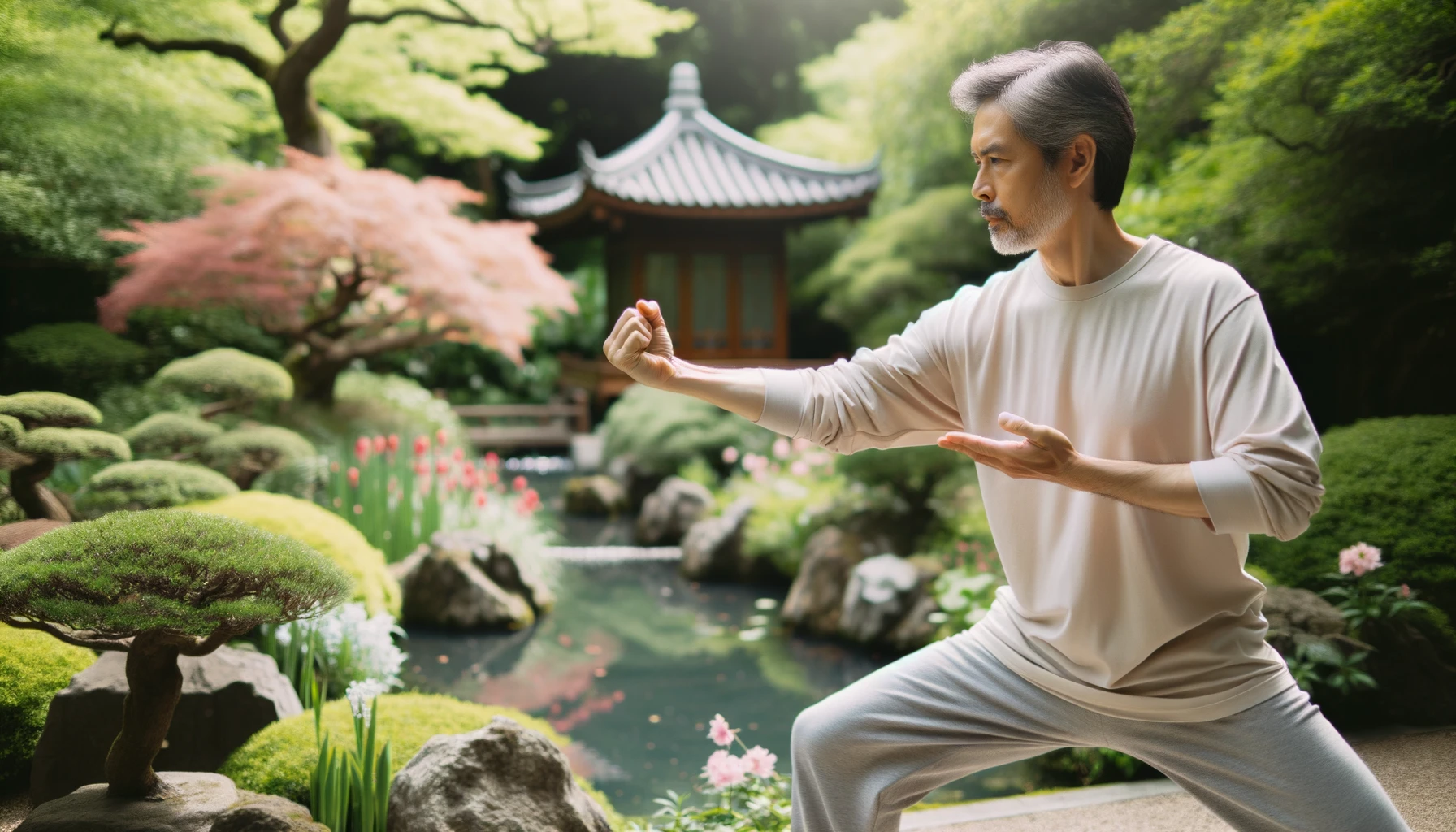
Are you looking to improve your flexibility? Discover how Qigong, an ancient practice, can help you achieve greater flexibility effortlessly.
Key Takeaways:
- Qigong incorporates dynamic movements and eccentric muscle contractions, promoting flexibility and strength in connective tissues.
- The mindfulness aspect of Qigong enhances self-awareness and breath control, contributing to improved flexibility.
- Regular Qigong practice can enhance agility, balance, bone health, and proprioception.
- Qigong offers immediate benefits without the risks associated with other forms of exercise.
- Consistency and moderation are key to experiencing the most benefits and avoiding injuries in Qigong flexibility training.
Qigong Exercises for Increased Flexibility
Unlock your body’s full potential for flexibility with these powerful Qigong exercises. Qigong is a holistic practice that combines mindful movement, breath control, and stretching techniques to promote flexibility and strength in the body. By incorporating these exercises into your regular routine, you can enhance your flexibility, improve your range of motion, and cultivate a greater sense of well-being.
One effective Qigong exercise for increased flexibility is the “Five Animal Frolics.” This exercise mimics the movements of animals, such as the tiger, deer, bear, monkey, and bird, to engage different muscle groups and promote overall flexibility. As you perform these gentle, flowing movements, you will stretch and strengthen your muscles, tendons, and ligaments, achieving a greater range of motion in your joints.
Another beneficial Qigong exercise is the “Three-Circle Standing.” This exercise involves standing in a relaxed, balanced posture and focusing on circular movements with your upper body. By gently rotating your arms, shoulders, and torso, you can release tension and stiffness in these areas, improving flexibility and mobility. This exercise also quiets the mind and improves body awareness, allowing you to connect with your body’s natural rhythms and enhance your overall sense of well-being.
Qigong Stretching Techniques
In addition to specific exercises, Qigong incorporates various stretching techniques to increase flexibility. One popular technique is “Hold the Ball Stretch.” In this exercise, you hold an imaginary ball in front of your body and gently stretch your arms out to the sides, feeling the stretch in your chest, shoulders, and upper back. This stretching technique helps to open up your chest and improve posture, while also increasing flexibility in your upper body.
Another effective stretching technique is the “Heel-to-Buttock Stretch.” This exercise involves lifting one leg behind you, bending your knee, and gently pulling your heel towards your buttock. This stretch targets the quadriceps muscles in the front of your thigh, helping to improve flexibility and reduce tightness in this area. By incorporating these stretching techniques into your Qigong practice, you can gradually improve your flexibility and enjoy a greater range of motion in your daily activities.
| Qigong Exercises for Increased Flexibility | Qigong Stretching Techniques |
|---|---|
| Five Animal Frolics | Hold the Ball Stretch |
| Three-Circle Standing | Heel-to-Buttock Stretch |
Benefits of Qigong for Flexibility
Discover the countless benefits of incorporating Qigong into your flexibility training routine. Qigong, with its dynamic movements and focus on mindfulness, offers a unique approach to enhancing flexibility and overall wellness. By practicing Qigong, you can experience an array of benefits that go beyond just increasing your range of motion.
One of the key advantages of Qigong for flexibility is its ability to promote eccentric muscle contractions and strengthen connective tissues. The dynamic movements and gentle stretches in Qigong help to improve flexibility and build strength in the muscles and joints. This can lead to improved agility and better performance in other physical activities.
In addition to the physical benefits, Qigong also offers mental and emotional advantages. The practice encourages self-awareness and mindfulness, fostering a deeper connection between the mind and body. By focusing on breath control and developing a sense of calm and relaxation, Qigong can help reduce stress, anxiety, and depression. It provides a holistic approach to wellness, addressing both the physical and emotional aspects of flexibility training.
Benefits of Qigong for Flexibility:
- Increased range of motion
- Improved muscle strength and flexibility
- Enhanced agility and balance
- Better bone health and proprioception
- Reduced stress, anxiety, and depression
Qigong offers immediate benefits without the risks associated with high-impact exercises. Its gentle movements and low-intensity nature make it accessible to people of all fitness levels and ages. Whether you are a beginner or an experienced athlete, integrating Qigong into your flexibility training routine can help you achieve a greater level of physical and mental well-being.
Table: Qigong Benefits
| Physical Benefits | Mental and Emotional Benefits |
|---|---|
| Increased flexibility | Reduced stress and anxiety |
| Improved muscle strength | Enhanced mindfulness |
| Enhanced agility and balance | Improved breath control |
| Better bone health | Relief from depression |
In conclusion, Qigong is a powerful practice that can significantly improve flexibility and overall wellness. By incorporating Qigong exercises into your flexibility training routine, you can experience increased range of motion, improved muscle strength, enhanced agility, and better bone health. Moreover, Qigong’s emphasis on mindfulness and breath control can help reduce stress, anxiety, and depression. So why not embrace the countless benefits of Qigong and take your flexibility training to the next level?
The Power of Qigong for Overall Wellness
Qigong isn’t just about flexibility – it’s a powerful practice that can positively impact your overall well-being. Through its combination of dynamic movements, mindfulness, and breath control, Qigong offers a holistic approach to enhancing both physical and mental health.
Regular practice of Qigong can lead to improved circulation, posture, balance, and strength. By incorporating gentle movements and deep breathing exercises, Qigong helps to stimulate and regulate the flow of energy throughout the body. This not only promotes physical vitality but also supports mental clarity and emotional well-being.
“In Qigong, we focus on cultivating a harmonious balance between the mind, body, and spirit,” says Qigong master, Sarah Lee. “By engaging in these intentional practices, we can experience a greater sense of inner peace, reduced stress, and heightened self-awareness.”
Furthermore, Qigong has shown promising results in relieving chronic pain and reducing symptoms of anxiety and depression. Its gentle and mindful approach provides a safe and accessible option for those seeking natural solutions to these common challenges.
Qigong Poses for Flexibility
While Qigong offers a multitude of benefits for overall wellness, it also plays a significant role in enhancing flexibility. By incorporating specific poses and stretching techniques, Qigong helps to increase the range of motion in the joints and improve overall flexibility.
Some popular Qigong poses for flexibility include the Butterfly Pose, Dragon Stance, and the Crane Stretch. These poses target different muscle groups and promote a greater range of motion, helping to release tension and improve flexibility.
| Qigong Pose | Benefits |
|---|---|
| Butterfly Pose | Opens up the hips, stretches the inner thighs, and promotes spinal flexibility. |
| Dragon Stance | Increases flexibility in the legs, hips, and lower back, while also improving balance and stability. |
| Crane Stretch | Enhances flexibility in the shoulder and upper back area, relieving tension and improving posture. |
By incorporating these poses into your regular Qigong practice, you can enhance your flexibility while reaping the many other benefits that Qigong offers. So, why not embrace the power of Qigong and discover a path to greater well-being?
The Importance of Regular Flexibility Training
Consistency is key when it comes to enhancing flexibility through Qigong – discover how to incorporate regular training into your routine. Qigong offers a variety of flexibility techniques that can help you improve your range of motion and overall physical well-being.
One effective way to structure your regular flexibility training is by incorporating Qigong exercises into your daily or weekly routine. By dedicating just a few minutes each day to practicing Qigong movements, you can gradually increase your flexibility over time.
Creating a schedule and setting aside specific times for your flexibility training can help you stay consistent. Consider adding flexibility-focused Qigong exercises to your morning or evening routine as a way to start or end your day with a mindful and energizing practice.
Benefits of Regular Flexibility Training with Qigong:
- Enhanced range of motion in joints and muscles
- Improved posture and alignment
- Increased muscle strength and flexibility
- Reduced muscle tension and stiffness
- Enhanced physical performance in other activities
Remember, it’s important to listen to your body and practice flexibility training at a pace that feels comfortable for you. Gradually increase the intensity and duration of your exercises as your flexibility improves.
Regular flexibility training with Qigong can lead to a greater sense of body awareness and overall well-being. By incorporating these practices into your routine, you can experience the many benefits Qigong has to offer. Start your journey towards enhanced flexibility today!
Conclusion: Embrace Qigong for Enhanced Flexibility and Wellness
Embrace the ancient practice of Qigong and unlock a new level of flexibility and wellness in your life. Qigong offers a holistic approach to enhancing flexibility by incorporating dynamic movements that promote eccentric muscle contractions, ultimately strengthening connective tissues. Through its mindfulness aspect, Qigong also helps develop self-awareness and breath control, allowing you to connect deeply with your body and its movements.
By incorporating Qigong exercises into your routine, you can experience a wide range of benefits beyond increased flexibility. Agility, balance, bone health, and proprioception can all be improved through regular Qigong practice. Furthermore, the immediate benefits of Qigong make it a safe and accessible option for those looking to improve flexibility without the risks associated with other forms of exercise.
However, it’s important to remember that consistency and moderation are key when it comes to flexibility training. By committing to a regular and moderate practice, you can maximize the benefits of Qigong and minimize the risk of injuries. The power of Qigong extends beyond flexibility, as it can also improve circulation, posture, balance, and overall strength. Additionally, it has been shown to relieve chronic pain and reduce feelings of anxiety and depression.
So, if you’re looking to enhance your flexibility and overall wellness, Qigong is a practice worth embracing. With its gentle yet effective techniques, Qigong can help you achieve a greater range of motion, improved vitality, and a deeper connection with yourself. Begin your journey today and experience the transformative power of Qigong!
FAQ
How does Qigong enhance flexibility?
Qigong enhances flexibility by practicing dynamic movements that promote eccentric muscle contractions, increasing flexibility and strength in connective tissues.
What other benefits does Qigong offer besides flexibility?
In addition to flexibility, Qigong focuses on mindfulness, self-awareness, breath control, and offers benefits such as improved agility, balance, bone health, proprioception, circulation, posture, balance, strength, relief from chronic pain, and reduced anxiety and depression.
Is Qigong a safe form of exercise for enhancing flexibility?
Yes, Qigong offers immediate benefits without the risks associated with other forms of exercise. However, it is important to engage in regular and moderate flexibility training to experience the most benefits.
Can Qigong help with chronic pain?
Yes, the practice of Qigong can relieve chronic pain by improving circulation, posture, balance, and strength.
How often should I practice Qigong for enhanced flexibility?
Consistency is key. Regular and moderate flexibility training when practicing Qigong will help you experience the most benefits and prevent injuries.



